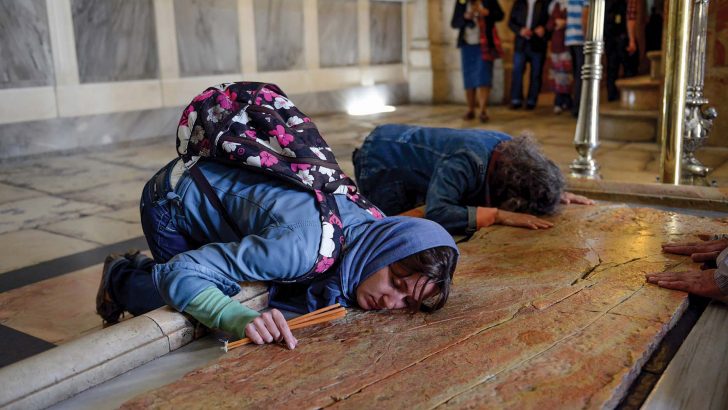A History of the Church through its Buildings
by Alan Doig (Oxford University Press, £30.00)
This is an unusual book by an author with unusual talents. Alan Doig studied architecture at King’s College Cambridge, later completing a doctorate in the same field. Having taught history of art for some seven years he was ordained into the Church of England and was for a time curate at Abingdon where he directed the restoration of a medieval painted ceiling in the Lady Chapel.
He was then appointed chaplain of Lady Margaret Hall in Oxford, and since has been involved in many conservation projects.
History
However, he brings to a history of churches through the ages the understanding of both a clergyman and an architect: this is very unusual indeed, for many architects have little inner feeling for what churches are meant for and how they are worked. Few parish clergy have any professional understanding of how architecture allows for human and religious activity: the jacket photograph of the architectural historian shows him in his clerical dress!
Rev. Doig’s twinned skills are brought to bear in this excellent and always stimulating book. There is something here for every kind of Christian, and for those who wish to gain a deeper insight into the nature of church buildings, theology and ritual.
The book opens with an account of the Church of the Holy Sepulchre in Jerusalem – in which the mythos of the salvation of humanity is engaged. He then moves on to Old St Peter’s Basilica at the Vatican, and the emergence of the dominance of Rome as Christianity emerged as the faith of a new empire. Naturally this then leads on to Hagia Sophia in modern-day Istanbul and – a chapter everyone in the West should read – an account of the Cathedral of the Dormition in Moscow’s Kremlin, still today at the heart of an empire.
It will be clear already how the book is structured, but it is the unusual detail and insights and perspectives that give the text its richness. Having dealt with the Renaissance and the spread of Christianity through the Iberian Empire, the last chapters however deal with the Crimean Memorial Church in Istanbul – “the English parish church exported” as he sees it now facing the sorry condition of Christians in Muslim lands.
Personally I found his account of Basil Spence’s Coventry Cathedral, his concluding chapter, deeply interesting. Here are echoes of familiar conflicts between those (especially the clergy) who are content with the replication of churches in era long past, and those who wish to have ‘something modern’ but never quite formulate or fix their ideas.
Coventry was an attempt in those post-war decades to renew the stream of faith, but what emerged was a compromise which did not always seem successful. Rev. Doig speaks of it as ‘Festival of Britain’ style of 1951, but neglects to mention that the cathedral was completed in the very first years of the Sunday colour magazine supplements which were to be the style arbiters in Britain for a generation.
Rebuilding
All across Europe at the time there was church rebuilding, especially in Germany, from which so much of the ‘new church architecture’ in Ireland in the last third of the 20th century flowed. There were those at the time, especially Catholics, who felt that the Catholic cathedral of Berlin, which faced with the same site problems as Coventry, achieved a more effective intersection of the ancient with new, for both faith and architecture.
So it will be seen that this always engaging and enlightening book will feed discussions and comments, both informed and superficial. It should not be thought though that this is a book only for ecclesiologists. Ordinary readers (and church-goers) will be richly informed and learn many things about history and theology which never have a place in the ordinary book of church architecture.
This is a book that deserves all the prizes available to celebrate its qualities.
Fifty Catholic churches to see before you die
by Elena Curti (Gracewing, £14.99)
This is quite a different book from Alan Doig’s original and insightful work. It is a sort of elegant tourist/pilgrims guide to a selection of historically-interesting churches in the eyes of the author, who is a journalist rather than an historian or architect. It is informed by piety, and an ambition to persuade English Catholics of the value of their heritage when it seems everywhere to be disdained by so many. She wants to show that Catholicism, despite its ups and downs, has been always been at the heart of English culture, in many different ways.
But it is as I say a book of pious celebration; it lacks the scholarly depth of Alas Doig’s book, which in the end is more truly revealing of the various stages of the Christian epoch.
Moreover it concentrates over much on the churches of the ‘second Spring’ in Victorian times, and on those that immediately strike the ordinary person as beautiful. Here I think there is a danger of confusing aesthetic pleasure with mystical insight.
Catholics should not need to be reminded that vestments and physically-beautiful churches do not change one whit the efficacy of the sacramental sacrifice offered in them in contrast, say, to a chapel in a poor Mexican village. The outpouring of grace is the same. These too are places where, (in those profound words of T.S. Eliot), “prayer has been valid”.
Still, the author is right that these are places well-worth visiting; but some thought should have been given to doing justice as well to the often far from beautiful chapels of the poor immigrant Catholics, the Irish, the Italians and latterly the Poles and Africans, in places like Liverpool, Glasgow, and the inner city of London.


 Peter Costello
Peter Costello Interior of the Church of the Holy Sepulchre, Jerusalem
Interior of the Church of the Holy Sepulchre, Jerusalem 